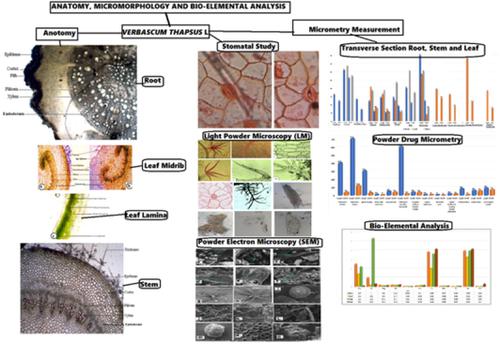当前位置:
X-MOL 学术
›
Microsc. Res. Tech.
›
论文详情
Our official English website, www.x-mol.net, welcomes your
feedback! (Note: you will need to create a separate account there.)
Micromorphology, pharmacognosy, and bio-elemental analysis of an important medicinal herb: Verbascum thapsus L.
Microscopy Research and Technique ( IF 2.0 ) Pub Date : 2020-02-06 , DOI: 10.1002/jemt.23454 Shafqat Ali Khan 1 , Ghulam Dastagir 2 , Noor Ul Uza 2 , Akhtar Muhammad 3 , Rahim Ullah 4
Microscopy Research and Technique ( IF 2.0 ) Pub Date : 2020-02-06 , DOI: 10.1002/jemt.23454 Shafqat Ali Khan 1 , Ghulam Dastagir 2 , Noor Ul Uza 2 , Akhtar Muhammad 3 , Rahim Ullah 4
Affiliation

|
The present study was conducted on characterization of morpho‐anatomical, phytochemical, and bio‐elemental analysis of root, stem, and leaf of Verbascum thapsus. Morphologically Verbascum is a biennial plant that flowers for a month and a half in mid‐ to late summer. Various organoleptic features of root, leaf, and stem were recorded. Anatomically the T. S of the root, stem, and leaf showed a typical dicot histological differentiation. Leaf possessed anomocytic stomata, crescent shape vascular bundles, and covered with long and stellate type trichomes while, stem contained collateral type of vascular bundles and a well‐developed pith to store phytochemicals responsible for various pharmacological activities. The powder drug study through scanning electron microscopy revealed the presence of various types of tissues. Branched, tree like and stellate trichomes in root and leaf help in absorption and reduce loss of water. These anatomical features are responsible for the survival of the plant as biennial. Four macro elements (Na, K, Ca, and Mg) and seven microelements (Cr, Cu, Fe, Mn, Ni, Zn, and Cd) and their concentrations in ppm were also studied using Atomic Absorption Spectroscopy. Phytochemical screening of methanolic extract showed existence of various secondary metabolites, while mucilage and anthraquinones was not detected. The present study helps to understand the taxonomic identification of the plant based on morpho‐anatomical features and throws the attention of the researchers to carry out the work for developing its various formulations, which can ultimately be beneficial for the human beings as well as animals.
中文翻译:

一种重要药用草药的微形态学,生药学和生物元素分析。
本研究在形态解剖学,植物化学和根,茎的生物元素分析,叶的特征进行了毛蕊花。从形态上讲是一种两年生植物,在夏末至夏末开花一个半月。记录了根,叶和茎的各种感官特征。解剖学上,根,茎和叶的T. S表现出典型的双子叶植物组织学分化。叶片具有不规则的气孔,新月形的维管束,并被长而星状的毛状体所覆盖,而茎则含有侧支型的维管束和成熟的髓,用以储存负责各种药理活性的植物化学物质。通过扫描电子显微镜对粉末药物的研究表明存在各种类型的组织。根和叶中的分支状,树状和星状毛状体有助于吸收并减少水分流失。这些解剖特征是植物每两年生存的原因。四个宏观元素(Na,K,还使用原子吸收光谱法研究了Ca和Mg)和七个微量元素(Cr,Cu,Fe,Mn,Ni,Zn和Cd)及其浓度(ppm)。甲醇提取物的植物化学筛选显示存在各种次生代谢产物,而未检测到粘液和蒽醌。本研究有助于理解基于形态解剖学特征的植物分类学鉴定,并引起研究人员的注意,以开展开发其各种配方的工作,这最终对人类和动物都有益。而未检测到粘液和蒽醌。本研究有助于理解基于形态解剖学特征的植物分类学鉴定,并引起研究人员的注意,以开展开发其各种配方的工作,这最终对人类和动物都有益。而未检测到粘液和蒽醌。本研究有助于理解基于形态解剖学特征的植物分类学鉴定,并引起研究人员的注意,以开展开发其各种配方的工作,这最终对人类和动物都有益。
更新日期:2020-02-06
中文翻译:

一种重要药用草药的微形态学,生药学和生物元素分析。
本研究在形态解剖学,植物化学和根,茎的生物元素分析,叶的特征进行了毛蕊花。从形态上讲是一种两年生植物,在夏末至夏末开花一个半月。记录了根,叶和茎的各种感官特征。解剖学上,根,茎和叶的T. S表现出典型的双子叶植物组织学分化。叶片具有不规则的气孔,新月形的维管束,并被长而星状的毛状体所覆盖,而茎则含有侧支型的维管束和成熟的髓,用以储存负责各种药理活性的植物化学物质。通过扫描电子显微镜对粉末药物的研究表明存在各种类型的组织。根和叶中的分支状,树状和星状毛状体有助于吸收并减少水分流失。这些解剖特征是植物每两年生存的原因。四个宏观元素(Na,K,还使用原子吸收光谱法研究了Ca和Mg)和七个微量元素(Cr,Cu,Fe,Mn,Ni,Zn和Cd)及其浓度(ppm)。甲醇提取物的植物化学筛选显示存在各种次生代谢产物,而未检测到粘液和蒽醌。本研究有助于理解基于形态解剖学特征的植物分类学鉴定,并引起研究人员的注意,以开展开发其各种配方的工作,这最终对人类和动物都有益。而未检测到粘液和蒽醌。本研究有助于理解基于形态解剖学特征的植物分类学鉴定,并引起研究人员的注意,以开展开发其各种配方的工作,这最终对人类和动物都有益。而未检测到粘液和蒽醌。本研究有助于理解基于形态解剖学特征的植物分类学鉴定,并引起研究人员的注意,以开展开发其各种配方的工作,这最终对人类和动物都有益。











































 京公网安备 11010802027423号
京公网安备 11010802027423号